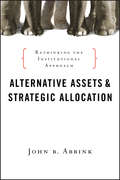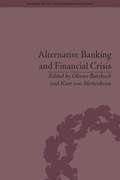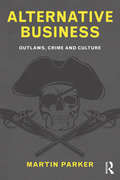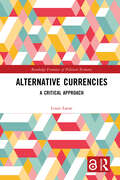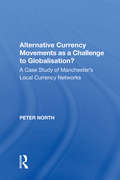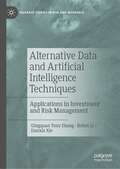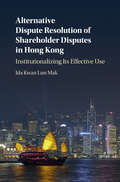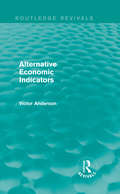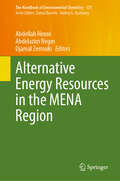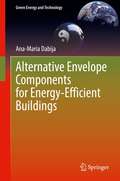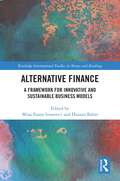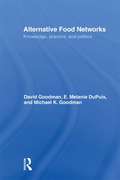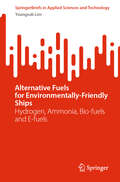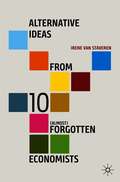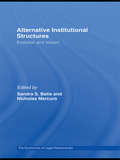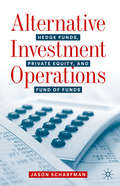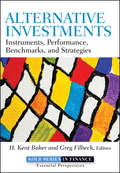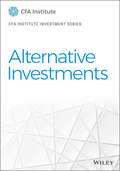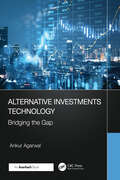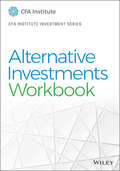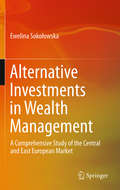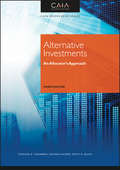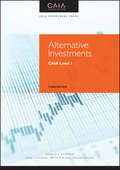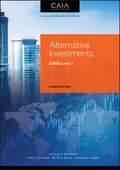- Table View
- List View
Alternative Assets and Strategic Allocation: Rethinking the Institutional Approach (Bloomberg #134)
by John B. AbbinkAn insightful guide to making strategic investment allocation decisions that embraces both alternative and conventional assets In this much-needed resource, alternative and portfolio management expert John Abbink demonstrates new ways of analyzing and deploying alternative assets and explains the practical application of these techniques. Alternative Assets and Strategic Allocation clearly shows how alternative investments fit into portfolios and the role they play in an investment allocation that includes traditional investments as well. This book also describes innovative methods for valuation as applied to alternatives that previously have been difficult to analyze. Offers institutional investors, analysts, researchers, portfolio managers, and financial academics a down-to-earth method for measuring and analyzing alternative assets Reviews some of the latest alternatives that are increasing in popularity, such as high-frequency trading, direct lending, and long-term investment in real assets Outlines a strategic approach for including alternative investments into portfolios and shows the pivotal role they play in an investment allocation Using the information found in this book, you'll have a clearer sense of how to approach investment issues related to alternative assets and discover what it takes to make these products work for you.
Alternative Banking and Financial Crisis (Banking, Money and International Finance #1)
by Olivier Butzbach Kurt Von MettenheimThe recent banking crisis has brought into question the business model used by most large banks. This collection of essays explores the success of ‘alternative banks’ – savings banks, cooperative banks and development banks, using case studies from around the world and discussion of both the historical and theoretical context of banking practices.
Alternative Business: Outlaws, Crime and Culture (Routledge Companions In Business, Management And Accounting Ser.)
by Martin ParkerFrom Robin Hood to Jack Sparrow from Pirates of the Caribbean, outlaws have been a central part of 800 years of culture. These are characters who criticise the power of those in the castle or the skyscraper, and earn their keep by breaking the law. Outlaws break categories too. They are fact and fiction, opposition and product, culture and economy, natural justice and organized crime. Beginning with Robin Hood stealing from the rich, and covering along the way pirates, smugglers, highwaymen, the Wild West, the Mafia and many others, Martin Parker offers a fresh and exciting insight into the counter culture of the outlaw – one that rebels against the more dominant and traditional forms of economy and organization and celebrates a life free from wage slavery. Alternative Business is a highly readable, entertaining book that will prove a helpful study tool for all students and lecturers working on organizations, cultural studies and criminology.
Alternative Currencies: A Critical Approach (Routledge Frontiers of Political Economy)
by Louis LarueA wide variety of new forms of money have been developed in recent decades as a challenge or complement to the official, dominant currencies. LETS, local currencies, carbon currencies, and Bitcoins are all examples of this new trend. These currencies are at the heart of a larger movement that questions the present state of money and argues that new currencies might help to build resilient economies and “warmer” social relations.This book focuses on radical alternative proposals as well as on small-scale experiments, and makes use of the analytical tools of philosophy and of economics, with one main question in mind: can alternative currencies constitute desirable alternatives to the present monetary system? Overall, the book will raise serious doubts regarding the capacity of such currencies to deliver on their promises. In part, it will show that several arguments in favour of alternative currencies are lacking in consistency and clarity, and are thus in need of thorough revision. More fundamentally, it will argue that these currencies rarely succeed in fulfilling their objectives and that their fulfilment would entail significant conflicts with justice and economic efficiency.This book is addressed to researchers in economics, politics, and philosophy of money, especially those working on alternative monetary systems.
Alternative Currency Movements as a Challenge to Globalisation?: A Case Study of Manchester's Local Currency Networks (Ashgate Economic Geography Ser.)
by Peter NorthOver the past 15 years, local money networks, which are essentially trading networks using a community-created currency, have emerged in countries as far apart as Argentina, Australia and New Zealand, Canada and the US, continental Europe and Japan. They range from Local Exchange Trading Schemes (UK), to Time Dollars (US), Green Dollars (New Zealand, Australia and Canada), Trading Circles (Hungary), Barter Networks (Argentina) and Talents (Germany). Drawing on an ethnographic case study of alternative currency movements in Manchester, UK, this book provides an analysis of the motivations, aims, successes and failures of alternative currency networks. It also raises questions such as the contribution of the alternative currency movement to current debates about alternatives to neoliberalism. While it is theoretically informed, critical and grounded in fieldwork, it is also sympathetic to the political aims of the protagonists and cognisant of the non-economic benefits that arise from their development.
Alternative Data and Artificial Intelligence Techniques: Applications in Investment and Risk Management (Palgrave Studies in Risk and Insurance)
by Beibei Li Qingquan Tony Zhang Danxia XieThis book introduces a state-of-art approach in evaluating portfolio management and risk based on artificial intelligence and alternative data. The book covers a textual analysis of news and social media, information extraction from GPS and IoTs data, and risk predictions based on small transaction data, etc. The book summarizes and introduces the advancement in each area and highlights the machine learning and deep learning techniques utilized to achieve the goals. As a complement, it also illustrates examples on how to leverage the python package to visualize and analyze the alternative datasets, and will be of interest to academics, researchers, and students of risk evaluation, risk management, data, AI, and financial innovation.
Alternative Dispute Resolution of Shareholder Disputes in Hong Kong: Institutionalizing Its Effective Use
by Mak Ida Kwan LunThe landscape of shareholder dispute resolution in Hong Kong has changed vastly since the launch of the Civil Justice Reform in 2009. Key initiatives - the voluntary court-connected scheme and reform of the statutory unfair prejudice provisions - were employed to promote the greater use of alternative dispute resolution (ADR) in shareholder disputes. While the Hong Kong government and judiciary introduced such schemes to prove the legitimacy of extra-judicial over court-based litigation processes, their success is still uncertain. In this book, socio-legal theory and sociological institutionalism are used to develop a theoretical framework for analyzing the key stages of institutionalization. The author analyzes how procedural innovations could acquire legitimacy through different types of legal and non-legal inducement mechanisms within the institutionalization process. Recommendations on codifying and innovating ADR policy in Hong Kong shareholder disputes made with comparison to similar policies in the United Kingdom, South Africa and New Zealand.
Alternative Economic Indicators (Routledge Revivals)
by Victor AndersonThe main objective of politicians is to maximise economic growth, which heavily drives political policy and decision-making. Critics of the maximisation of growth as the central aim of economic policy have argued that growth in itself is not necessarily a good thing, particularly for the environment; however, what would replace the system and how it would be measured are questions that have been rarely answered satisfactorily. First published in 1991, this book was the first to lay out an entirely new set of practical proposals for developing new economic measurement tools, with the aim of being sustainable, ‘green’ and human-centred. Victor Anderson proposes that a whole set of indicators, rather than a single one, should play all the roles that GNP (Gross National Product) is responsible for. With a detailed overview of the central debates between the advocates and opponents of continued economic growth and an analysis of the various proposals for modification, this title will be of particular value to students interested in the diversity of measurement tools and the notion that economies should also be evaluated by their social and environmental consequences.
Alternative Energy Resources in the MENA Region (The Handbook of Environmental Chemistry #131)
by Abdelazim Negm Abdellah Henni Djamal ZerroukiThis book outlines the development of renewable energies in the Middle East and North Africa, it offers up-to-date information about their variability, availability and utilization, and serves as a guide for understanding the MENA renewable energy potential. Readers will find an authoritative discussion about the implementation of renewable energies, trends and forecast of solar, wind and geothermal systems applications in this region. Case studies from China, Mexico and Vietnam are also included in this book to foster the implementation of renewable energies in the MENA region. The MENA region is known for its immense oil, petroleum and gas reserve, being one of the most important regions in the world for fossil energy accessibility and, hence, for the global economic stability. This region holds at the same time the world’s greatest potential for renewable energy and over the past few years it has been receiving national and international political support for promoting the future of solar and wind power energies. However, can the region go green taking into account the availability of the natural resources? Expert contributors from countries such as United Arab Emirates, Egypt, Algeria, Turkey, and Morocco provide their perspective on this challenge and offer a comprehensive overview of the latest pilot projects for renewable energy in the region. This book will appeal to researchers, students, engineers and policymakers interested in the potential of alternative energy resources in the MENA region.
Alternative Envelope Components for Energy-Efficient Buildings (Green Energy and Technology)
by Ana-Maria DabijaThis book examines ways of saving energy by using green roofs and facades, solar devices such as building-integrated photovoltaics (BIPV), and thermal solar panels, as components of energy-efficient building envelopes. The author takes an interdisciplinary / multidisciplinary approach to the subject that analyzes several different scientific fields connected to building research—sustainability, sustainable architecture, energy efficiency in buildings, and building envelopes—while approaching other collateral domains, including history, archaeology, botanics, physics, engineering, and landscape architecture. Alternative Envelope Components for Energy-Efficient Buildings will be a welcome resource for researchers, students, and postgraduates in the fields of energy, building materials, and renewable energy, as well as architects, engineers, and specialists in industries related to building products.Looks at the impact of building envelopes on energy usage;Offers readers an introduction to the principles of sustainability;Presents passive and active approaches to using solar devices.
Alternative Finance: A Framework for Innovative and Sustainable Business Models (Routledge International Studies in Money and Banking)
by Mina Fanea-Ivanovici Hasnan BaberThe alternative financing space has grown exponentially in the last few decades, namely as a consequence of the financial crisis, technological advancement, niche customer segments, and more recently the pandemic. Now, with the inclusion of Fintech, online lenders, crowdfunding, accelerators, venture capitalists, or angel investors, this funding channel is no longer seen as a substitute for formal financing, but rather a core one. This book is a comprehensive guide to alternative financing methods, offering insights into emerging trends, the role of FinTech, and the intersection of finance with sustainability, innovation, and entrepreneurship.It fills a knowledge gap by exploring innovative financing channels such as fintech, green finance, and venture capital as well as other non-traditional ways of raising funds, which have become crucial for startups and businesses. It discusses the impact of financial technology (FinTech) on these methods and their function in supporting entrepreneurship and sustainable business, while also examining the implications of these technological advancements in the wider financial sector. It addresses challenges and opportunities for entrepreneurs and explores how alternative financing options can support growth and innovation, particularly in the context of environmentally and socially focused ventures, including how to integrate economic, social, and environmental considerations. The emphasis on sustainability and green finance aligns with the growing global concern for responsible business practices and the Sustainable Development Goals.While the primary audience for the book is scholars, researchers, and students, the inclusion of case studies, and the exploration of various financing options, extends practical cues for policymakers and practitioners and contributes to the understanding of how finance, entrepreneurship, and sustainability intersect in real-world business scenarios.
Alternative Food Networks: An Interdisciplinary Assessment
by Alessandro Corsi Filippo Barbera Egidio Dansero Cristiana PeanoIn recent years, Alternative Food Networks (AFNs) have been a key issue both in the scientific community and in public debates. This is due to their profound implications for rural development, local sustainability, and bio-economics. This edited collection discusses what the main determinants of the participation of operators – both consumers and producers – in AFNs are, what the conditions for their sustainability are, what their social and environmental effects are, and how they are distributed geographically. Further discussions include the effect of AFNs in structuring the food chain and how AFNs can be successfully scaled up.The authors explicitly take an interdisciplinary approach to analyse AFNs from different perspectives, using as an example the Italian region of Piedmont, a particularly interesting case study due to the diffusion of AFNs in the area, as well as due to the fact that it was in this region that the ‘Slow Food’ movement originated.
Alternative Food Networks: Knowledge, Practice, and Politics (Routledge Studies of Gastronomy, Food and Drink)
by David Goodman Michael K. Goodman E. Melanie DuPuisFarmers’ markets, veggie boxes, local foods, organic products and Fair Trade goods – how have these once novel, "alternative" foods, and the people and networks supporting them, become increasingly familiar features of everyday consumption? Are the visions of "alternative worlds" built on ethics of sustainability, social justice, animal welfare and the aesthetic values of local food cultures and traditional crafts still credible now that these foods crowd supermarket shelves and other "mainstream" shopping outlets? This timely book provides a critical review of the growth of alternative food networks and their struggle to defend their ethical and aesthetic values against the standardizing pressures of the corporate mainstream with its "placeless and nameless" global supply networks. It explores how these alternative movements are "making a difference" and their possible role as fears of global climate change and food insecurity intensify. It assesses the different experiences of these networks in three major arenas of food activism and politics: Britain and Western Europe, the United States, and the global Fair Trade economy. This comparative perspective runs throughout the book to fully explore the progressive erosion of the interface between alternative and mainstream food provisioning. As the era of "cheap food" draws to a close, analysis of the limitations of market-based social change and the future of alternative food economies and localist food politics place this book at the cutting-edge of the field. The book is thoroughly informed by contemporary social theory and interdisciplinary social scientific scholarship, formulates an integrative social practice framework to understand alternative food production-consumption, and offers a unique geographical reach in its case studies.
Alternative Fuels for Environmentally-Friendly Ships: Hydrogen, Ammonia, Bio-fuels and E-fuels (SpringerBriefs in Applied Sciences and Technology)
by Youngsub LimThis book reports on current shipping and shipbuilding industries' efforts for decarbonization. It demonstrates what regulations have been made for large ships on international voyages and points to what is to change in the future. The book also quantitatively reviews the current challenges of alternative fuels such as hydrogen, ammonia, biofuels, and e-fuels, considering economics, safety, and greenhouse gas emissions assessments.
Alternative Ideas from 10 (Almost) Forgotten Economists
by Irene van StaverenHow should we address today’s big problems, and what we can take from icons of economics past? How would John Maynard Keynes have resolved today’s debt problem, or how would Adam Smith have assessed the European carbon emission trading market? This book applies the ideas of ten renowned economists (Marx, Minsky, Keynes, Knight, Bergmann, Veblen, Sen, Myrdal, Smith, Robinson) to real world economic problems, directly or indirectly related to the causes and consequences of the 2008 financial crisis. Each chapter presents an economist, and structures the ‘problem’, the ‘insight’ (the economist’s idea), the ‘economist’ (short bio), and two ‘practices’ offering real-world alternatives. This book presents a lively and original approach that will be of interest to economists and non-economists alike, discussing key elements of an economics for a postcapitalist economy and connecting policy insights to real-world problems of today.
Alternative Institutional Structures: Evolution and impact (The\economics Of Legal Relationships Ser.)
by Nicholas Mercuro Sandra S. BatieIn the spring on 2006, a workshop was held at Michigan State University to honour the career of A. Allan Schmid and his writings about how institutions evolve and how alternative institutions, including property rights, shape political relationships and impact economic performance. This edited book is the outcome of the workshop. It is a collection
Alternative Investment Operations: Hedge Funds, Private Equity, and Fund of Funds
by Jason ScharfmanAlternative investments such as hedge funds, private equity, and fund of funds continue to be of strong interest among the investment community. As these investment strategies have become increasingly complex, fund managers have continued to devote more time and resources towards developing best practice operations to support the actual trade processing, fund accounting, and back-office mechanics that allow these strategies to function. Representative of this operational growth, estimates have indicated that fund managers have seen increased operating budgets of 30% or more in recent years.In today’s highly regulated environment, alternative investment managers have also increasingly had to integrate rigorous compliance and cybersecurity oversight into fund operations. Additionally, with recent advances in artificial intelligence and big data analysis, fund managers are devoting larger portions of their information technology budgets towards realizing technology-based operational efficiencies. Alternative investment fund service providers have also substantially increased their scope and breadth of their operations-related services. Furthermore, investors are increasingly performing deep-dive due diligence on fund manager operations at both fund level and management company levels.This book provides current and practical guidance on the foundations of how alternative investment managers build and manage their operations. While other publications have focused on generalized overviews of historical trading procedures across multiple asset classes, and the technical intricacies of specific legacy operational procedures, Alternative Investment Operations will be the first book to focus on explaining up-to-date information on the specific real-world operational practices actually employed by alternative investment managers. This book will focus on how to actually establish and manage fund operations. Alternative Investment Operations will be an invaluable up-to-date resource for fund managers and their operations personnel as well as investors and service providers on the implementation and management of best practice operations.
Alternative Investments
by H. Kent Baker Greg FilbeckA comprehensive guide to alternative investments that reveals today's latest research and strategiesHistorically low interest rates and bear markets in world stock markets have generated intense interest in alternative investments. With returns in traditional investment vehicles relatively low, many professional investors view alternative investments as a means of meeting their return objectives. Alternative Investments: Instruments, Performance, Benchmarks, and Strategies, can put you in a better position to achieve this difficult goal.Part of the Robert W. Kolb Series in Finance, Alternative Investments provides an in-depth discussion of the historic performance, benchmarks, and strategies of every major alternative investment market. With contributions from professionals and academics around the world, it offers valuable insights on the latest trends, research, and thinking in each major area. Empirical evidence about each type of alternative investment is featured, with research presented in a straightforward manner.Examines a variety of major alternative asset classes, from real estate, private equity, and commodities to managed futures, hedge funds, and distressed securitiesProvides detailed insights on the latest research and strategies, and offers a thorough explanation of historical performance, benchmarks, and other critical informationBlends knowledge from the conceptual world of scholars with the pragmatic view of practitioners in this fieldAlternative investments provide a means of diversification, risk control, and return enhancement and, as such, are attractive to many professional investors. If you're looking for an effective way to hone your skills in this dynamic area of finance, look no further than this book.
Alternative Investments (CFA Institute Investment Series)
by CFA InstituteThe complete guide to alternative investments, from experts working with CFA Institute Alternative Investments is the definitive guide to understanding non-traditional asset classes. Alternatives are a disparate group of investments that are distinguished from long-only, publicly traded investments in stocks, bonds, and cash (often referred to as traditional investments). Alternative investments include real estate, commodities, infrastructure, and other non-traditional investments such as private equity or debt and hedge funds. They are attractive to investors because of the potential for portfolio diversification resulting in a higher risk-adjusted return for the portfolio. Alternative Investments and its accompanying workbook (sold separately) lead students and investment professionals through the many characteristics of non-traditional assets, including: Narrow specialization of the investment managers Relatively low correlation of returns with those of traditional investments Less regulation and less transparency than traditional investments Limited historical risk and return data Unique legal and tax considerations Higher fees, often including performance or incentive fees Concentrated portfolios Restrictions on redemptions (i.e. “lockups” and “gates”) CFA Institute is the world's premier association for investment professionals, and the governing body for the CFA® Program, CIPM® Program, CFA Institute ESG Investing Certificate, and Investment Foundations® Program. Those seeking a deeper understanding of the markets, mechanisms, and use of alternatives will value the level of expertise CFA Institute brings to the discussion, providing a clear, comprehensive resource for students and professionals alike. Whether used alone or in conjunction with the companion workbook, Alternative Investments offers a complete course in alternative investments and their role in investment management.
Alternative Investments Technology: Bridging the Gap
by Ankur AgarwalThe alternative investments technology market is still considered young and highly diverse, driving varied technology needs. Few players can address the needs of the entire market, while new specialized providers continue to emerge, making choices even more complex. Investors now demand more rigorous due diligence, greater access to senior management, and more detailed, frequent data reports before committing to funds. In response, firms must be agile, ready to reassess, and revamp their operations and practices.Alternative Investments Technology: Bridging the Gap is tailored for investment professionals, managers, and technologists navigating this evolving landscape. It explores how technology enhances management and investment processes, helping firms maintain competitive advantage and operational efficiency. The book provides insights into leveraging technology for better decision-making, improved efficiency, and enhanced investor outcomes. As technology integration in alternative investments evolves, staying informed is essential. This book serves as an indispensable guide to thriving in this dynamic environment.
Alternative Investments Workbook (CFA Institute Investment Series)
by CFA InstituteHands-on practice with alternative investments based on real-world scenarios Alternative Investments Workbook provides the key component of effective learning—practice. Designed for both students and investment professionals, this companion workbook conveniently aligns with the Alternative Investments text chapter-by-chapter, offers brief chapter summaries to refresh your memory on key points before you begin working, and explicitly lays out the learning objectives so you understand the “why” of each problem. This workbook helps you: Synthesize essential material from the Alternative Investments text using real-world applications Understand the key characteristics of non-traditional investments Work toward specific chapter objectives to internalize important information CFA Institute is the world's premier association for investment professionals, and the governing body for the CFA® Program, CIPM® Program, CFA Institute ESG Investing Certificate, and Investment Foundations® Program. Those seeking a deeper understanding of the markets, mechanisms, and use of alternatives will value the level of expertise CFA Institute brings to the discussion as well as the extra practice delivered in Alternative Investments Workbook based on real scenarios investors face every day.
Alternative Investments in Wealth Management: A Comprehensive Study of the Central and East European Market
by Ewelina SokołowskaThis monograph provides a comprehensive source of analysis and research on alternative investments in the wealth management process, with a special focus on Poland and Eastern Europe. It presents the characteristics that distinguish alternative investments from traditional investments and illustrates the benefits and risks involved in the former. The experience gained in developed countries is extremely valuable for the analysis of both the Polish and Eastern European financial markets. In the theoretical part of the book, key aspects of alternative investments are collected, systematized and developed; subsequently, in the empirical part the results of selected studies on the alternative investment sector around the world are examined. Lastly, the book's findings are applied to the context of alternative financial investments in Poland, investigating the preferences for alternative investments in the country, which is the largest market in Central and Eastern Europe. Not only of theoretical interest, these insights have a high application value, making the book an essential resource for scholars, practitioners and policymakers alike.
Alternative Investments: An Allocator's Approach (Wiley Finance Ser.)
by CAIA Association Keith H. Black Donald R. Chambers Hossein B. KazemiWhether you are a seasoned professional looking to explore new areas within the alternative investment arena or a new industry participant seeking to establish a solid understanding of alternative investments, Alternative Investments: An Allocator's Approach, Fourth Edition (CAIA Level II curriculum official text) is the best way to achieve these goals. In recent years, capital formation has shifted dramatically away from public markets as issuers pursue better financial and value alignment with ownership, less onerous and expensive regulatory requirements, market and information dislocation, and liberation from the short-term challenges that undergird the public capital markets. The careful and informed use of alternative investments in a diversified portfolio can reduce risk, lower volatility, and improve returns over the long-term, enhancing investors' ability to meet their investment outcomes. Alternative Investments: An Allocator's Approach (CAIA Level II curriculum official text) is a key resource that can be used to improve the sophistication of asset owners and those who work with them. This text comprises the curriculum, when combined with supplemental materials available at caia.org, for the CAIA Level II exam. "Over the course of my long career one tenet has held true, 'Continuing Education'. Since CalSTRS is a teachers' pension plan, it is no surprise that continuing education is a core attribute of our Investment Office culture. Overseeing one of the largest institutional pools of capital in the world requires a cohesive knowledge and understanding of both public and private market investments and strategies. We must understand how these opportunities might contribute to delivering on investment outcomes for our beneficiaries. Alternative Investments: An Allocator's Approach is the definitive core instruction manual for an institutional investor, and it puts you in the captain's chair of the asset owner."—Christopher J. Ailman, Chief Investment Officer, California State Teachers’ Retirement System "Given their diversified cash flow streams and returns, private markets continue to be a growing fixture of patient, long-term portfolios. As such, the need to have proficiency across these sophisticated strategies, asset classes, and instruments is critical for today's capital allocator. As a proud CAIA charterholder, I have seen the practical benefits in building a strong private markets foundation, allowing me to better assist my clients."—Jayne Bok, CAIA, CFA, Head of Investments, Asia, Willis Tower Watson
Alternative Investments: CAIA Level I (Wiley Finance)
by CAIA Association Mark J. Anson Hossein Kazemi Keith H. Black Donald R. ChambersThe official CAIA Level 1 curriculum bookAlternative Investments: CAIA Level I, 3rd Edition is the curriculum book for the Chartered Alternative Investment Analyst (CAIA) Level I professional examination. Covering the fundamentals of the alternative investment space, this book helps you build a foundation in alternative investment markets. You'll look closely at the different types of hedge fund strategies and the range of statistics used to define investment performance as you gain a deep familiarity with alternative investment terms and develop the computational ability to solve investment problems. From strategy characteristics to portfolio management strategies, this book contains the core material you will need to succeed on the CAIA Level I exam. This updated third edition tracks to the latest version of the exam, and is accompanied by the following ancillaries: a workbook, study guide, learning objectives, and an ethics handbook. Most investment analyst education programs focus primarily on the traditional asset classes, pushing alternative investments to the sidelines. The CAIA designation was developed in response to the tremendous growth of alternative investing, and is the industry's premier educational standard. This book is your official study companion, bringing you fully up to speed on everything you need to know (with the exception of the ethics material covered in a separate handbook). Understand the complexities of each alternative asset class Learn the quantitative techniques professionals use every day Dig into the unique aspects of alternative investments Master the core material covered by the CAIA Level I exam More than 300 financial institutions and hedge funds have committed key executives to the CAIA exam, and this rapidly growing trend speaks to the designation's rising status as a must-have credential for anyone in the alternative investment sphere. Increase your chances of success by getting your information straight from the source in CAIA Level I.
Alternative Investments: CAIA Level I (Wiley Finance)
by CAIA Association Mark J. Anson Keith H. Black Donald R. Chambers Hossein B. KazemiAlternative Investments: CAIA Level I, 4th Edition is the curriculum book for the Chartered Alternative Investment Analyst (CAIA) Level I professional examination. Covering the fundamentals of the alternative investment space, this book helps you build a foundation in alternative investment markets. You'll look closely at the different types of hedge fund strategies and the range of statistics used to define investment performance as you gain a deep familiarity with alternative investment terms and develop the computational ability to solve investment problems. From strategy characteristics to portfolio management strategies, this book contains the core material you will need to succeed on the CAIA Level I exam. This updated fourth edition tracks to the latest version of the exam and is accompanied by the following ancillaries: a workbook, study guide, learning objectives, and an ethics handbook.
